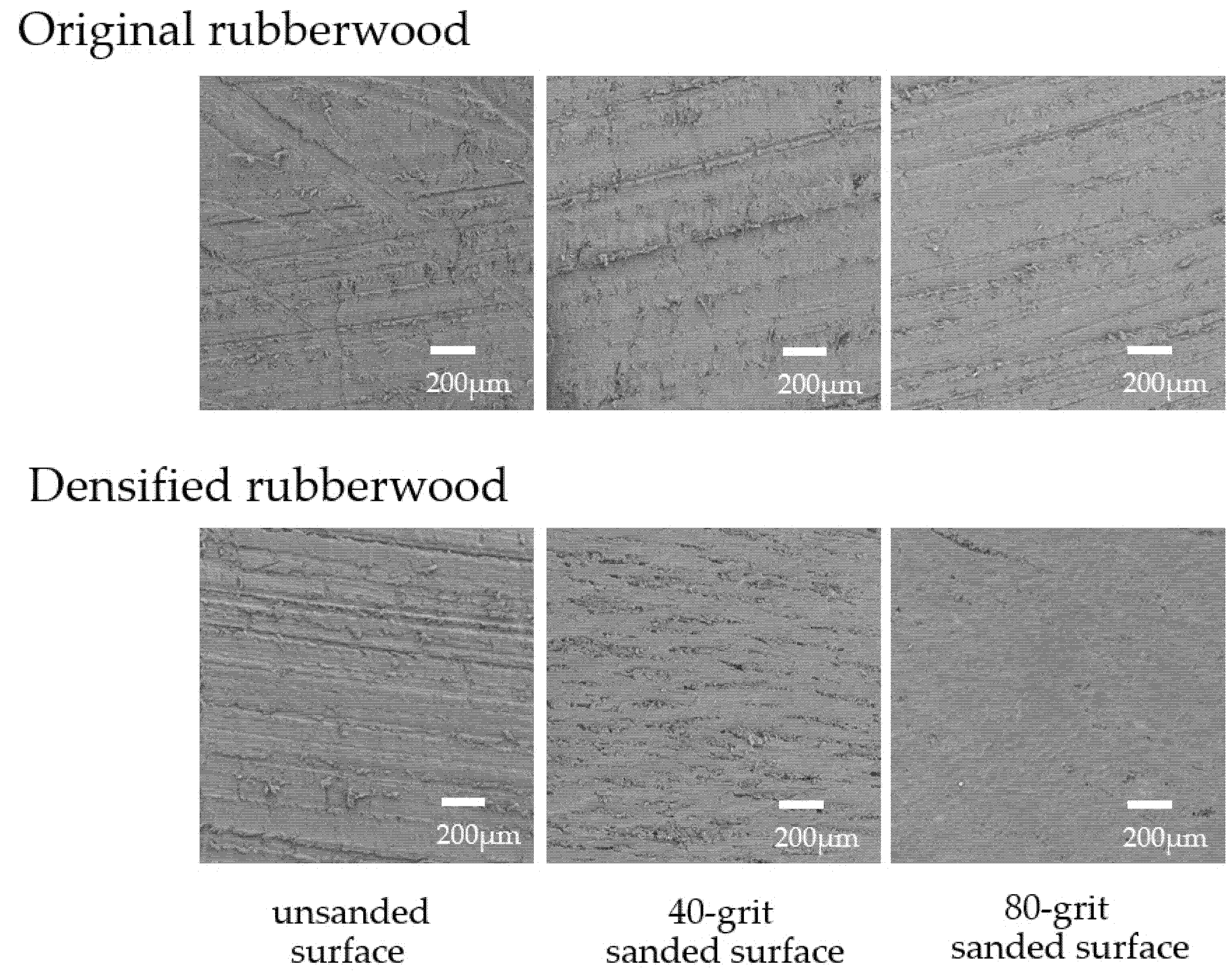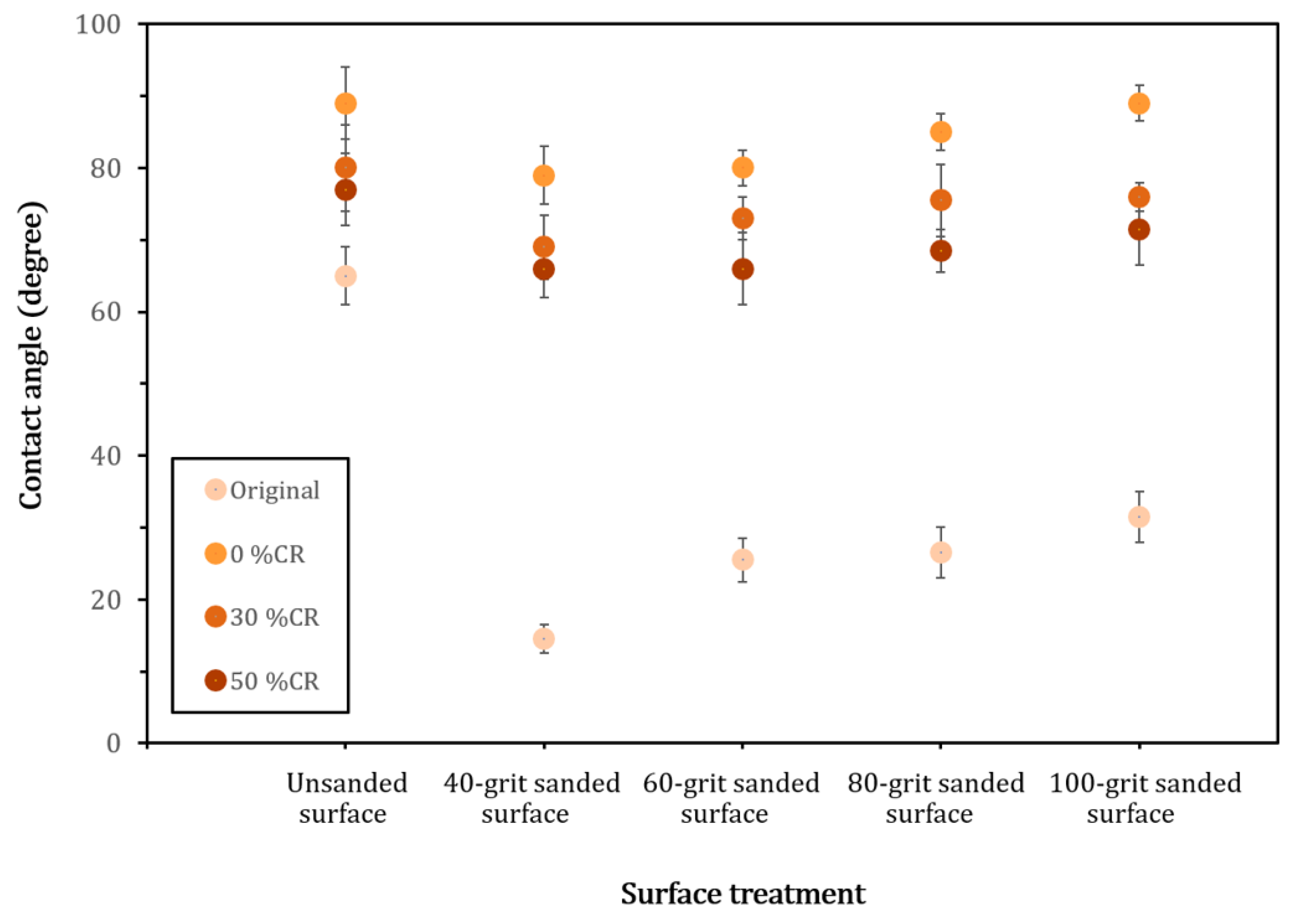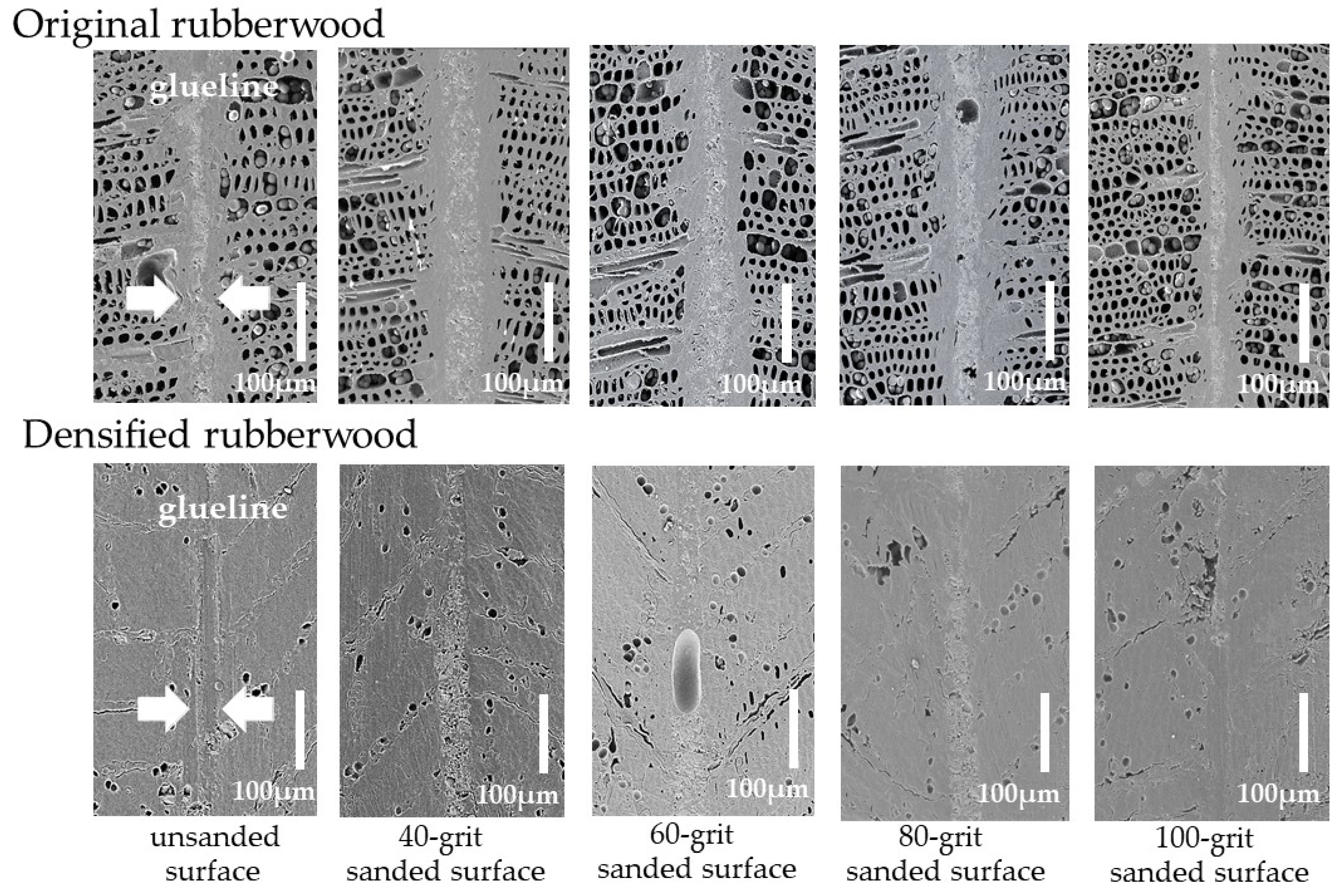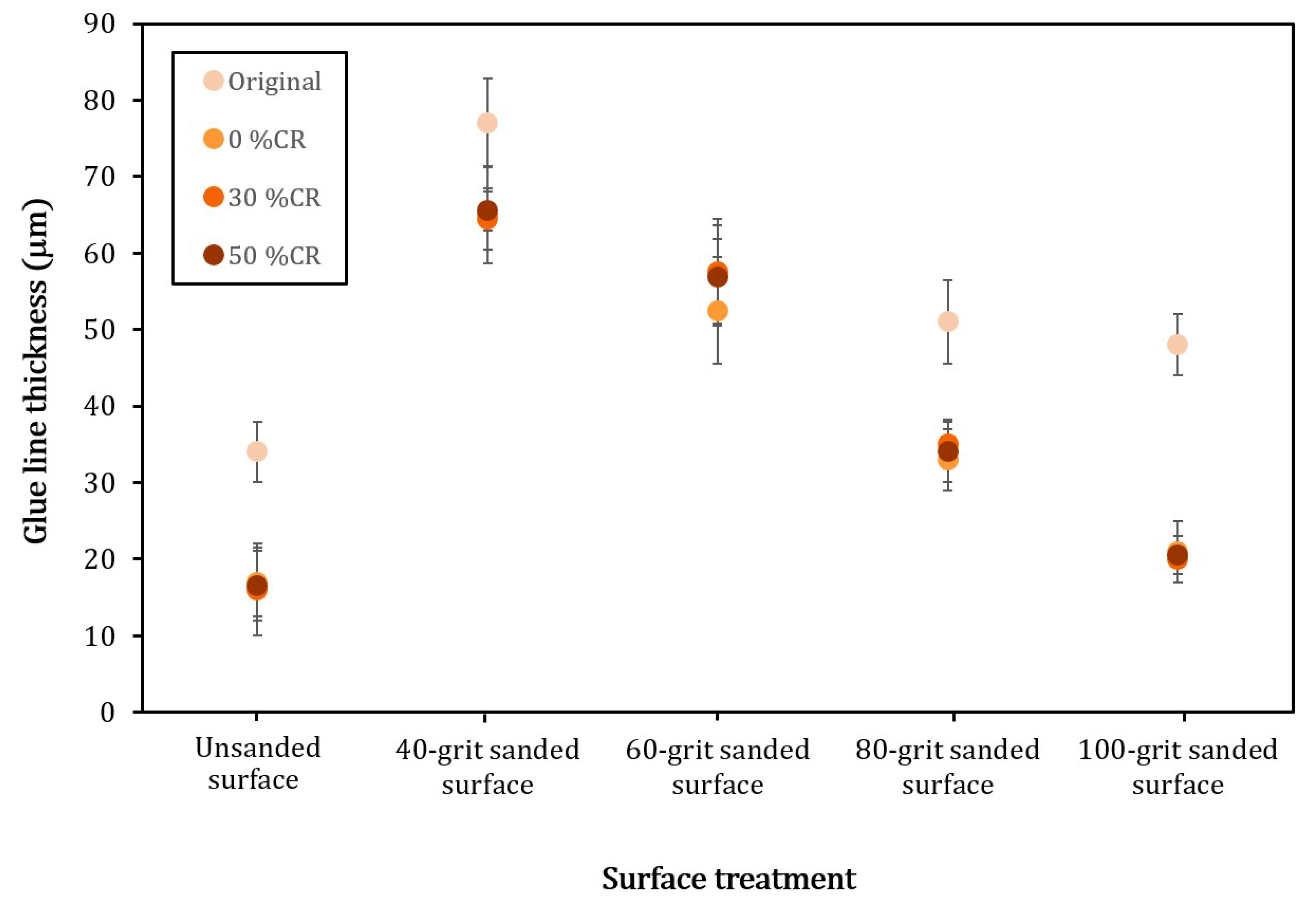High-Performance Adhesive Joint Made from Densified Wood
Abstract
:1. Introduction
2. Materials and Methods
2.1. Preparation of Densified Rubberwood
2.2. Adhesive Joint Preparation
2.3. Monitoring of Properties
2.3.1. Contact Angle
2.3.2. Scanning Electron Microscopy
2.3.3. Glueline Thickness
2.3.4. Block Shear Strength
3. Results and Discussion
3.1. Densification Process for Rubberwood
3.2. Topography and Wettability at the Surface of Rubberwood Samples
3.3. Characteristic of the Adhesive Joint
3.4. Shear Strength of the Adhesive Joint
4. Conclusions
Author Contributions
Funding
Institutional Review Board Statement
Informed Consent Statement
Data Availability Statement
Acknowledgments
Conflicts of Interest
References
- Sulaiman, O.; Hashim, R.; Subari, K.; Liang, C.K. Effect of sanding on surface roughness of rubber wood. J. Mater. Process. Technol. 2008, 209, 3949–3955. [Google Scholar] [CrossRef]
- Matan, N.; Kyokong, B. Effect of moisture content on some physical and mechanical properties of juvenile rubberwood (Hevea brasiliensis Muell. Arg.). Songklanakarin J. Sci. Technol. 2003, 25, 327–340. [Google Scholar]
- Devi, R.R.; Maji, T.K. Studies of properties of rubber wood with impregnation of polymer. Bull. Mater. Sci. 2002, 25, 527–531. [Google Scholar] [CrossRef]
- Devi, R.R.; Maji, T.K. Effect of glycidyl methacrylate on the physical properties of wood–polymer composites. Polym. Compos. J. 2007, 28, 1–5. [Google Scholar] [CrossRef]
- Meethaworn, B.; Khongtong, S. The tuneable rubberwood: Roles of polymer impregnated level. Wood Mater. Sci. Eng. 2020, 16, 397–406. [Google Scholar] [CrossRef]
- Meethaworn, B.; Srivaro, S.; Khongtong, S. A novel densifying method for the development of high strength rubberwood for structural application. Constr. Build. Mater. 2020, 265, 120862–120871. [Google Scholar] [CrossRef]
- Banea, M.D.; da Silva, L.F. Adhesively bonded joints in composite materials: An overview. Proc. Inst. Mech. Eng. Part L J. Mater. Des. Appl. 2009, 223, 1–18. [Google Scholar] [CrossRef]
- Collett, B.M. A review of surface and interfacial adhesion in wood science and related fields. Wood Sci. Technol. 1972, 6, 1–42. [Google Scholar] [CrossRef]
- Gavrilović-Grmuša, I.; Dunky, M.; Miljković, J.; Djiporović-Momčilović, M. Influence of the degree of condensation of urea-formaldehyde adhesives on the tangential penetration into beech and fir and on the shear strength of the adhesive joints. Eur. J. Wood Wood Prod. 2012, 70, 655–665. [Google Scholar] [CrossRef]
- Marra, A.A. Technology of Wood Bonding: Principles in Practice; Van Nostrand Reinhold: New York, NY, USA, 1992; pp. 78–99. [Google Scholar]
- Ghumatkar, A.; Budhe, S.; Sekhar, R.; Banea, M.D.; de Barros, S. Influence of adherend surface roughness on the adhesive bond strength. Lat. Am. J. Solids Struct. 2016, 13, 2356–2370. [Google Scholar] [CrossRef] [Green Version]
- Uehara, K.; Sakurai, M. Bonding strength of adhesives and surface roughness of joined parts. J. Mater. Process. Technol. 2002, 127, 178–181. [Google Scholar] [CrossRef]
- Vick, C.B. Adhesive bonding of wood materials. In Wood Handbook-Wood as an Engineering Material; USDA Forest Service, Forest Products Laboratory: Madison, WI, USA, 1999; pp. 9.1–9.24. [Google Scholar]
- Aicher, S.; Ahmad, Z.; Hirsch, M. Bondline shear strength and wood failure of European and tropical hardwood glulams. Eur. J. Wood Wood Prod. 2018, 76, 1205–1222. [Google Scholar] [CrossRef] [Green Version]
- Budhe, S.; Ghumatkar, A.; Birajdar, N.; Banea, M.D. Effect of surface roughness using different adherend materials on the adhesive strength. Appl. Adhes. Sci. 2015, 3, 20. [Google Scholar] [CrossRef] [Green Version]
- Frihard, C.R.; Hunt, C.G. Wood adhesive: Bond formation and performance. In Wood Handbook-Wood as an Engineering Material; USDA Forest Service, Forest Products Laboratory: Madison, WI, USA, 2021; pp. 10.1–10.23. [Google Scholar]
- Thongcharoen, N.; Khongtong, S.; Srivaro, S.; Wisadsatorn, S.; Chub-uppakarn, T.; Chaowana, P. Development of structural insulated panels made from wood-composite boards and natural rubber foam. Polymers 2021, 13, 2497. [Google Scholar] [CrossRef] [PubMed]
- Necasova, B.; Liska, P.; Kelar, J.; Slanhof, J. Comparison of adhesive properties of polyurethane adhesive system and wood-plastic composites with different polymers after mechanical, chemical and physical surface treatment. Polymers 2019, 11, 397. [Google Scholar] [CrossRef] [PubMed] [Green Version]
- Tan, W.; Na, J.; Zhou, Z. Effect of service temperature on mechanical properties of adhesive joints after hygrothermal aging. Polymers 2021, 13, 3741. [Google Scholar] [CrossRef] [PubMed]
- ASTM D905-08; Standard Test Method for Strength Properties of Adhesive Bonds in Shear by Compression Loading. ASTM Annual Book of Standards. ASTM International: West Conshohoken, PA, USA, 2021.
- Skaar, C. Water in Wood; Syracuse University Press: New York, NY, USA, 1972; pp. 122–137. [Google Scholar]
- Gardner, D.J.; Generalla, N.C.; Gunnells, D.W.; Wolcott, M.P. Dynamic wettability of wood. Langmuir 2019, 7, 2498–2501. [Google Scholar] [CrossRef]
- Ozdemir, T.; Hiziroglu, S.; Malkocoglu, A. Influence of relative humidity on surface quality and adhesion strength of coated medium density fiberboard (MDF) panels. Mater. Des. 2009, 30, 2543–2546. [Google Scholar] [CrossRef]
- Zisman, W.A. Influence of constitution on adhesion. Ind. Eng. Chem. 1963, 55, 19–38. [Google Scholar] [CrossRef]





| Properties | GSP PU 902H | GSP PU 902 |
|---|---|---|
| Chemical types Appearance | Polyol Gray slurry | Diisocyanate Brown liquid |
| Density (at 30 °C) g/cm3 | 0.98 | 1.20 |
| Viscosity (at 30 °C) cps. | 700 | 200 |
| Wood Samples | MU (wt%) | PL (wt%) | ρ0 (wt%) |
|---|---|---|---|
| Original rubberwood | - | - | 0.69 ± 0.02 |
| Densified rubber wood with 0% CR | 67.09 ± 2.83 | 53.49 ± 4.37 | 1.05 ± 0.03 |
| Densified rubber wood with 30% CR | 54.09 ± 3.06 | 35.67 ± 2.88 | 1.22 ± 0.04 |
| Densified rubberwood with 50% CR | 43.13 ± 2.81 | 16.82 ± 1.38 | 1.30 ± 0.02 |
| Wood Used to Make Joints | ||||
|---|---|---|---|---|
| Surface | Original Wood | 0% CR Wood | 30% CR Wood | 50% CR Wood |
| Non-abraded | 100% | 0% | 0% | 0% |
| 40-grit sanded | 100% | 20% | 30% | 60% |
| 60-grit sanded | 100% | 60% | 80% | 100% |
| 80-grit sanded | 100% | 60% | 90% | 100% |
| 100-grit sanded | 100% | 20% | 40% | 80% |
Publisher’s Note: MDPI stays neutral with regard to jurisdictional claims in published maps and institutional affiliations. |
© 2022 by the authors. Licensee MDPI, Basel, Switzerland. This article is an open access article distributed under the terms and conditions of the Creative Commons Attribution (CC BY) license (https://creativecommons.org/licenses/by/4.0/).
Share and Cite
Meethaworn, B.; Srivaro, S.; Khongtong, S. High-Performance Adhesive Joint Made from Densified Wood. Polymers 2022, 14, 515. https://doi.org/10.3390/polym14030515
Meethaworn B, Srivaro S, Khongtong S. High-Performance Adhesive Joint Made from Densified Wood. Polymers. 2022; 14(3):515. https://doi.org/10.3390/polym14030515
Chicago/Turabian StyleMeethaworn, Benjama, Suthon Srivaro, and Sureurg Khongtong. 2022. "High-Performance Adhesive Joint Made from Densified Wood" Polymers 14, no. 3: 515. https://doi.org/10.3390/polym14030515






